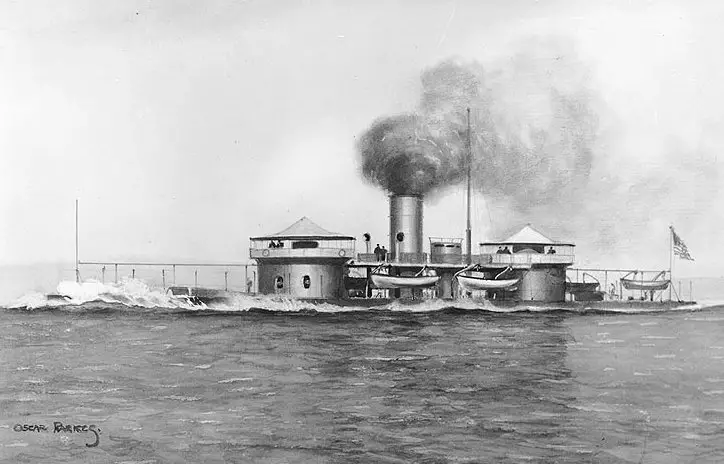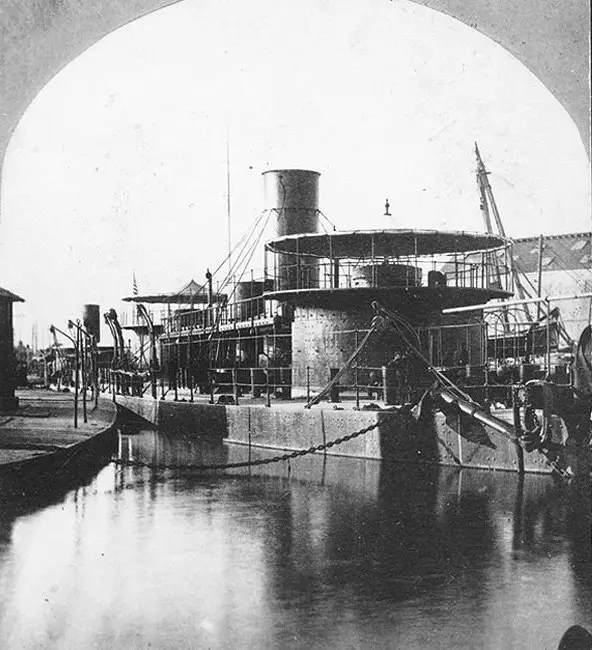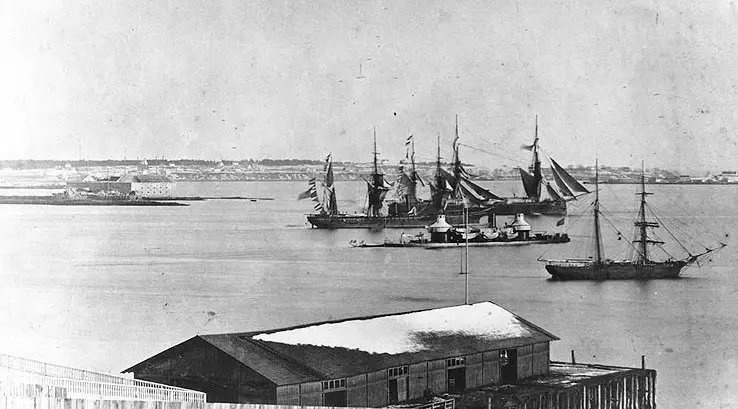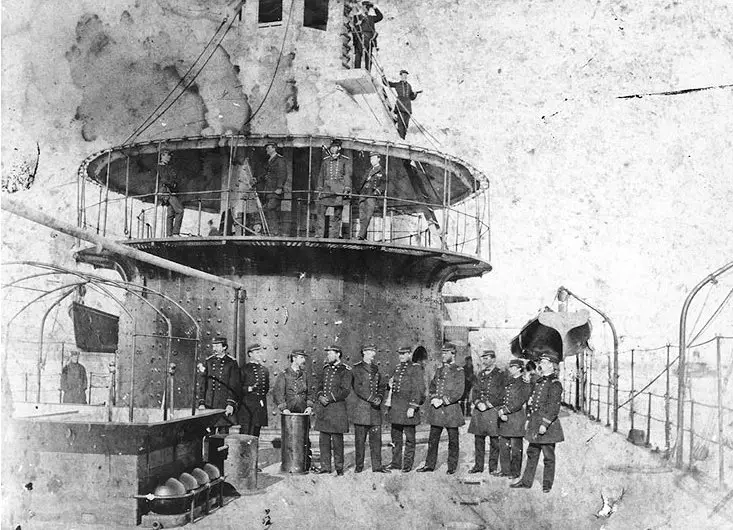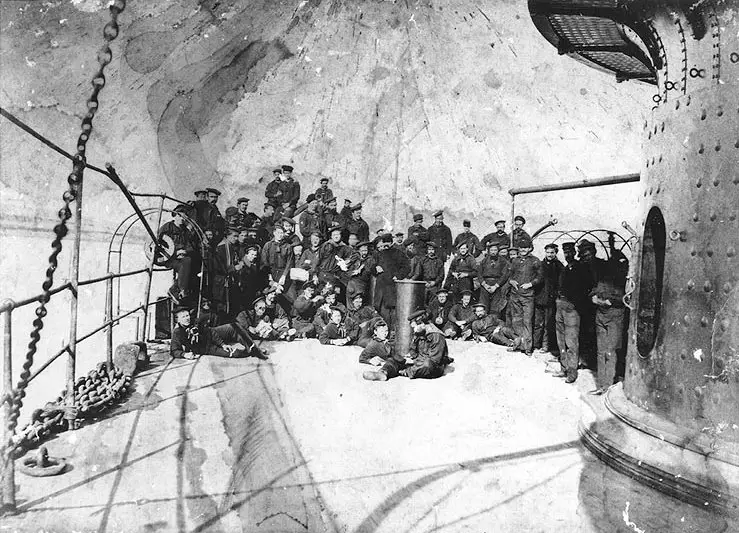USS Miantonomoh
Civil War Union Naval Ship
USS Miantonomoh (1865-1874)USS Miantonomoh , a 3401-ton twin-turret monitor, was built at the New York Navy Yard, Brooklyn, New York. Commissioned in September 1865, she served briefly with the North Atlantic Squadron along the U.S. east coast, then was inactive at the Washington Navy Yard, D.C., until April 1866. After a short stay at New York, in early May Miantonomoh departed on a historic trans-Atlantic voyage, accompanied by USS Augusta and USS Ashuelot . Carrying Assistant Secretary of the Navy Gustavus V. Fox for most of the trip, she arrived in Ireland in mid-June to begin nearly a year of visits to ports from the Baltic to the Mediterranean. Miantonomoh was decommissioned at Philadelphia, Pennsylvania, in July 1867, soon after returning to the U.S. from Europe. She recommissioned in November 1869. In January 1870, she steamed north to meet the British ironclad Monarch and USS Plymouth , which were bringing the body of the great philanthropist George Peabody back to Massachusetts for burial. The monitor then operated along the U.S. Atlantic coast until July 1870, when she was laid up at the boston Navy Yard. During that period of active service, she was involved in two collisions, sinking the schooner Sarah at New York in December 1869 and the Navy tug Maria off Martha's Vinyard, Massachusetts, in January 1870. In 1874-75, as part of a program to "rebuild" Civil War era monitors into modern ones, her wooden hull was broken up and construction of a new iron-hulled ship, also named Miantonomoh , was begun at Chester, Pennsylvania, essentially retaining only the name of the original. Watercolor by Oscar Parkes Moored off the Washington Navy Yard, D.C., in 1865-66. USS Montauk is tied up alongside, to the left. |
 War, Technology, and Experience aboard the USS Monitor The experience of the men aboard the Monitor and their reactions to the thrills and dangers that accompanied the new machine. The invention surrounded men with iron and threatened their heroism, their self-image as warriors, even their lives Kindle Available  Naval Strategies of the Civil War: Confederate Innovations and Federal Opportunism Compare and contrast the strategies of the Southern Secretary of the Navy, Mallory, against his rival in the North, Welles. Mallory used technological innovation and the skill of individuals to bolster the South's seapower against the Union Navy's superior numbers |
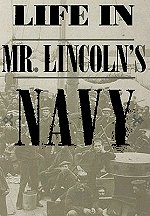 Life in Mr. Lincoln's Navy A tantalizing glimpse into the hardships endured by the naval leadership to build and recruit a fighting force. The seaman endured periods of boredom, punctuated by happy social times and terrifying bouts of battle horror  Ironclad Down: USS Merrimack-CSS Virginia from Design to Destruction A treasure trove of detailed information about one of history s most famous vessels. Describing Stephen Russell Mallory, John Mercer Brooke, John Luke Porter, et al.--who conceived, designed and built one of the world's first ironclads 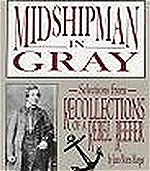 Midshipman in Gray: Selections from Recollections of a Rebel Reefer Kindle Available  Confederate Ironclad vs Union Ironclad: Hampton Roads 1862 The Ironclad was a revolutionary weapon of war. Although iron was used for protection in the Far East during the 16th century, it was the 19th century and the American Civil War that heralded the first modern armored self-propelled warships. |
Washington Navy Yard, D.C. Peabody Funeral Fleet, January 1870 Ship's junior officers on her afterdeck, circa 1869-1870. Enlisted crewmen on board, circa 1869-1870. |
 Civil War Musket Wood & Steel Frontier Rifle Designed After The Original Rifle 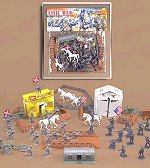 72 Piece Civil War Army Men Play Set 52mm Union and Confederate Figures, Bridge, Horses, Canon
| Civil War Ships and Battles Civil War Submarines RAM Ships Civil War Naval Timeline American Civil War Exhibits State Battle Maps Civil War Summary Civil War Timeline Women in the Civil War Battles by Campaign |
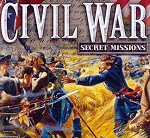 History Channel Civil War Secret Missions There are about a half-dozen different small arms types, but the Henry is the best for rapid repeating fire and least reloading. The shotgun they give you is useless: you must aim spot-on to affect an enemy, so why not just use the rifle? Grenades are useful at times.  Civil War Model 1851 Naval Pistol |
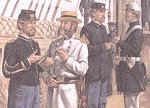 American Civil War Marines 1861-65 Marines wearing blue and grey fought in many dramatic actions afloat and ashore – ship-to-ship engagements, cutting-out expeditions, and coastal landings. This book offers a comprehensive summary of all such battles, illustrated with rare early photographs |
 Union River Ironclad 1861-65 At the start of the American Civil War, neither side had warships on the Mississippi River. In what would prove the vital naval campaign of the war, both sides fought for control of the river. While the Confederates relied on field fortifications and small gunboats, the Union built a series of revolutionary river ironclads |
Kindle Available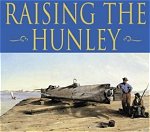 Raising the Hunley: The Remarkable History and Recovery of the Lost Confederate Submarine For more than a century the fate of the Hunley remained one of the great unsolved mysteries of the Civil War. Then, on August 8, 2000, with thousands of spectators crowding Charleston Harbor, the Hunley was raised from the bottom of the sea and towed ashore. |
 The Story of the H.L. Hunley During the Civil War, Union forces blockade the port of Charleston so the Confederate army seeks a way to attrack the Yankee Ships. George Dixon is part of the group of men given the task of creating and building the "fish boat," a submarine. The H.L. Hunley ultimately sets out on its mission to sink Yankee ships, but fails to return, its whereabouts unknown. |
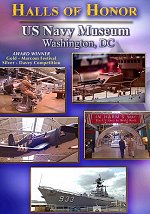 Halls of Honor The U.S. Navy Museum takes you on an informed and entertaining romp through one of North America s oldest and finest military museums. The museum has been in continuous operation at the Washington Navy Yard since the American Civil War |
 Raise The Alabama She was known as "the ghost ship." During the Civil War, the CSS Alabama sailed over 75,000 miles and captured more than 60 Union vessels. But her career came to an end in June of 1864 when she was sunk by the USS Kearsarge off the coast of Northern France |
 The Civil War - A Film by Ken Burns Here is the saga of celebrated generals and ordinary soldiers, a heroic and transcendent president and a country that had to divide itself in two in order to become one |
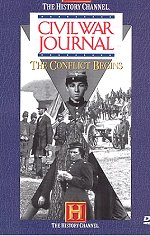 Civil War Journal The Conflict Begins These four programs from the History Channel series Civil War Journal cover critical aspects of the early days of the war. |
Sources:
U.S. National Park Service
U.S. Library of Congress
US Naval Archives
|
Books Civil War Womens Subjects Young Readers Military History DVDs Confederate Store Civil War Games Music CDs Reenactors |

